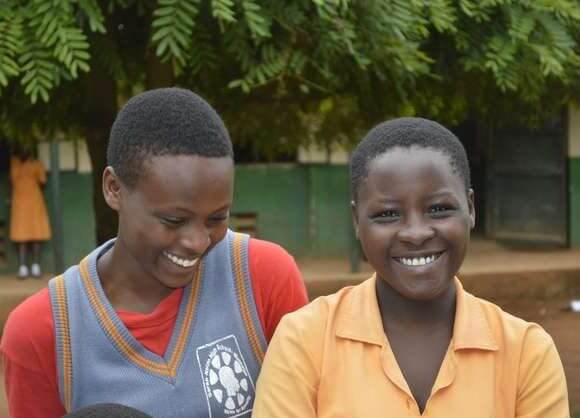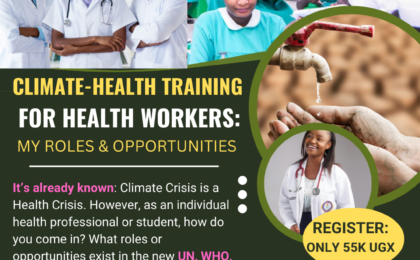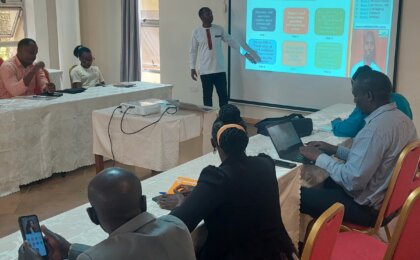Evidence: Policy factors leading to adolescent mother deaths!
Every year, about 21 million girls (15-19 years) become pregnant in developing countries, with 12 million of them actually giving birth. And of these 12 million births, 777,000 of them happen among those below 15 years! (World Health Organization, 2020).
While the estimated global adolescent fertility rate has declined, the actual number of births among teenage girls hasn’t simply because their population has tremendously grown!
In Uganda, adolescent pregnancy is at 25% nationally, which is high. A serious side effect of unwanted adolescent pregnancy is unsafe abortion, especially in countries where abortion is illegal (for example, Uganda).
Globally, about 3.9 million unsafe abortions occur among 15-19 girls each year! In Uganda, there are about 297,000 induced abortions each year, with a bigger number of them not receiving any treatment even after complications! Even for those who seek care, confirms Dr. Kiggundu, they are beyond saving! Below is how Guttmacher institute breaks down the adolescent pregnancy and abortion trouble!


In general, adolescent pregnancy leads to serious maternal and child consequences, including death due to the increased obstetric risks during adolescent pregnancy and child delivery, induced abortions, and related socio-economic limitations. In this article, I will discuss the policy-related factors that are fueling this and more other factors responsible for maternal mortality, especially among adolescent mothers!
Policy and adolescent mother mortality!
‘On paper, Uganda has good policies to address the health challenges associated with adolescent pregnancy. However, these policies are poorly implemented….’ (Wallace, 2011). Since 1999, Uganda has tried to put in place relevant health policies. According to Tanga (2016), adolescents and their issues were partly considered in a 1999’s National Minimum Healthcare Package by Uganda’s ministry of health.
From then, Tanga adds, more other policies (for example, the 2001 Adolescent Health Policy Guidelines and Service Standards, the 2004 National Adolescent Health Policy, 2000 Health Sector Strategic and Investment Plan, the recent 2018 national sexuality education frame work and many more) have been put in place. However, notes Wallace (2011), there is lack of proper and full implementation of these health policies.
Tanga (2016) adds that this failure to implement policies is compounded by the restrictive culture and traditions in Uganda that oppose most policies’ initiatives.
READ THIS TOO: How is our culture killing mothers, especially teenage mothers
Another policy related factor that predisposes young women to pregnancy related complications and death is ignorance and unawareness about relevant reproductive health policies (Wallace, 2011). Actually, Wallace cites Neema et al. (2004) who extends this ignorance and unawareness to policy makers and stakeholders themselves. This leads to unfair treatment of pregnant adolescent mothers by individuals, relatives, boyfriends, and various institutions, and consequent inability of these ‘ignorant’ adolescents to look for justice (Wallace, 2011).
Concerning this, while the Ministry of Health through national adolescent health policy emphasizes that women who get pregnant while schooling should be allowed to continue with their studies (whether in primary, secondary or tertiary institutions) (Wallace, 2011 and Oluka, 2013), the education policy and institutions are quiet on this (Darabi et al., 2008).
Indeed, in various institutions, many pregnant young women have suffered numerous prejudices and discriminations, including termination of their studies in various institutions, and consequently leading to abortions, poor health and deaths (Wallace, 2011 and Oluka, 2013).
The Daily Monitor of 09th November 2013 published a painful story that revealed the challenges that young mothers unfairly go through in different institutions (for example, Uganda Christian University, Islamic University in Uganda, and, recently, Mulago school of nursing and midwifery) in Uganda on grounds of their pregnancy.
The result of these harassments, discrimination, and prejudices, cites Wallace (2011), is psychological torture, social pressure, lack of support, and unsafe abortions, consequently leading to high adolescent maternal deaths. The current report emphasizes that about 30% of maternal deaths would be averted if abortions reduced (National Population Council-NPC, 2018).
On this, I would like to thank the government of Uganda that, through the Ministry of Education and Sports, has allowed students who got pregnant during COVID19 lockdown to sit for their exams (2021). This is a great step towards the real freedom, especially for girl child. With more than 100,000 adolescent pregnancies during the lockdown, allowing them to continue education is the best we can do after failing to protect them from such happenings!
However, as shown by many skeptics regarding this new development (captured by the Independent Magazine here), don’t be surprised if there are institutions somewhere still mistreating them (adolescent mothers), especially Catholic and Protestant based institutions!
Otherwise, in Uganda, pregnant girls are just chased out of school. Period.
Wallace (2011) hints on shortage of funds as a major factor negatively affecting policy implementation in Uganda. According to Uganda’s national population status reports 2014, 2017 and 2018, Ministry of Health’s share on national budget is still low and this has persistently affected all health policies especially those to do with reproductive health.
For example, in 2012, Uganda promised to increase family planning financing from 2 million US dollars to US$ 5 million per year for the next five years, a commitment that wasn’t met in the financial years of 2015/2016 and 2016/2017 (NPC, 2018) and this, partly, accounts for the 30% unmet need for family planning (UDHS, 2016).
It should be noted that while the knowledge regarding contraception is high (about 98 to 99%) (Nalwadda et al., 2011), utilization is still low, especially among adolescents (about 10-20%) (UDHS, 2016 and Tanga, 2016); The utilization improves a little bit ONLY following the first birth or abortion (Rutaremwa, 2013 and Kabagenyi et al., 2016). This clearly accounts for the higher maternal mortality among adolescent mothers.
Another policy related factor is corruption (NPC, 2018). As cited by NPC’s 2018 State of the Population Report, the 2017 Ibrahim Index of African Governance ranked Uganda at a low score of between 11 and 22 out of 100 for the 3 years of 2014, 2015 and 2016. Actually, Uganda Police’s 2017 annual crime report says that major corruption cases increased from 28 in 2016 to 38 in 2017 (Uganda Police, 2017).
According to the latest 2019 annual crime report, corruption cases increased to 64 from 32 in 2018! As elaborated by Ministry Of Finance, Planning and Economic Development through the 2018 population status report, corruption in form of bribes, especially in health system, raises the cost of services, blocks access to timely quality health information, and consequently leads to poor service delivery and utilization among the already poor and unemployed adolescents or young people (The state of Uganda population report, 2018). In the words of the report:
In an effort to improve access to health services and efficiency in utilization, Uganda abolished user fees at public health facilities in 2001. Despite this, users still incur healthcare expenses in the form of under the table (bribes) payments. Data from Afro-barometer shows that the proportion of Ugandans who reported making unsanctioned payments in exchange for health services decreased from 25 percent in 2015 to 19 percent in 2017 (Afrobarometer, 2017). Despite the reduction, ‘the highest percentage of respondents reported to have paid bribes to health and police workers at 43% and 40% respectively’ (UBOS, 2018). Informal payments for care reduce access to services by making care less affordable, especially for the poor (NPC: The state of Uganda population report, 2018; Page 62).
In some cases, there hasn’t been clear policies or any form of national guidelines. For example, on abortion, which is one of the serious issue contributing to high adolescent maternal mortality, the law has been strict (abortion is illegal) (Moore et al., 2014) and the exceptions (abortion may be permissible if the mother’s life is in danger) aren’t clear in Uganda’s penal code nor are they known by the masses (Tanga et al., 2016).
Despite the fact that sexuality education is effective in relation to empowering young women and improving reproductive health issues such as abortions, Sexually Transmitted Infections (STIs) and HIV, domestic violence and education (Katuhaire and Kaberuka, 2016; Ministry of Education and Sports-Uganda, 2018), for long, the government had no sexuality education framework until May 2018 when the first one was drafted (United Nations Populations Fund-UNFPA, 2018).
This lack of proper and clear policy on abortion and sexuality education hampers or hampered efforts to reduce adolescent maternal mortality. Besides, not all institutions have received the newly designed guideline, implying a serious challenge in delivery of sexuality education to young people.
Concerning the new national sexuality education framework 2018, we are now in 2021 (April 2021) and it isn’t implemented yet! Meanwhile, see how we are utilizing the framework to avail comprehensive sexuality education to youth and adolescents.
REFERENCES
Atuhaire Ruth and Kaberuka Will (2016). Factors Contributing to Maternal Mortality in Uganda. African Journal of Economic Review, Volume IV, Issue 2, July 2016.
Darabi, L., et al. (2008). Protecting the Next Generation in Uganda: New Evidence on Adolescent Sexual and Reproductive Health Needs. New York: Guttmacher Institute.
Kabagenyi, A., Habaasa , G., & Rutaremwa, G. (2016). Low Contraceptive Use among Young Females in Uganda: Does birth history and age at birth have an influence? Analysis of 2011 Demographic and Health Survey. Journal of Contraceptive Studies.
Ministry of Education and Sports-Uganda (2018). National Sexuality Education Framework 2018
Ministry of Finance, Planning and Economic Development (2018). The state of Uganda population report 2018. Good governance; a prerequisite to harness the demographic dividend for sustainable development. Kampala (Uganda).
Moore, Ann M.; Kibombo, Richard; Cats-Baril, Deva (2014). “Ugandan opinion-leaders’ knowledge and perceptions of unsafe abortion”. Health Policy and Planning. 29 (7): 893 901. doi:10.1093/heapol/czt070. PMID 24064047.
Uganda Bureau of Statistics-UBOS (2018). 2017 National Governance Peace and Security Report.
Kampala: Uganda Bureau of Statistics. https://www.ubos.org/wp-content/uploads/publications/12_2018The_NGPSS_Report_2017.pdf, accessed on 4th April 2021.
Oluka Esther (2013). Dilemma of pregnant girls at Uganda Christian University. Daily Monitor, 10th November 2013: https://mobile.monitor.co.ug/Life/Dilemma-of-pregnant-girls-at-Uganda-Christian-University/1055104-2066516-format-xhtml-sk976gz/index.html, accessed on 01/01/2019.
Rutaremwa, G. (2013). Factors Associated with Adolescent Pregnancy and Fertility in Uganda: Analysis of the 2011 Demographic and Health Survey Data. Social Sciences, 2 (1), 7-13.
Tanga Jenkins (2016). Young people’s sexual reproductive health in Uganda, Munich, GRIN Verlag, https://www.grin.com/document/351379
UNFPA (2018). The government of Uganda launches the National Sex Education Framework 2018-https://uganda.unfpa.org/en/news/government-uganda-launches-national-sexuality-education-framework, accessed on 24/09/2018
Wallace, A. (2011, November). Adolescent pregnancy and Policy Responses in Uganda. Africa Portal-a project of Africa initiative. No.14 November 2011.




